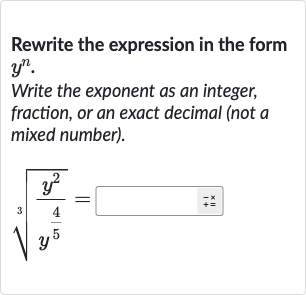AI tutor
Welcome to Bytelearn!
Let’s check out your problem:

Rewrite the expression in the form .Write the exponent as an integer, fraction, or an exact decimal (not a mixed number).
Full solution
Q. Rewrite the expression in the form .Write the exponent as an integer, fraction, or an exact decimal (not a mixed number).
- Rewrite as Exponent: Apply the property of radicals to rewrite the cube root as an exponent.
- Simplify with Power Rule: Use the power rule of exponents to simplify the expression.^{(/)} becomes which simplifies to .^{(/)} becomes which simplifies to .
- Divide Using Quotient Rule: Now, divide the two expressions using the quotient rule for exponents.
- Subtract Exponents: To divide the expressions with the same base, subtract the exponents.
- Find Common Denominator: Find a common denominator to subtract the fractions in the exponents.The common denominator for and is .
- Subtract Fractions: Subtract the fractions in the exponent.
- Simplify Fraction: Simplify the fraction in the exponent. simplifies to because and have a common factor of .
